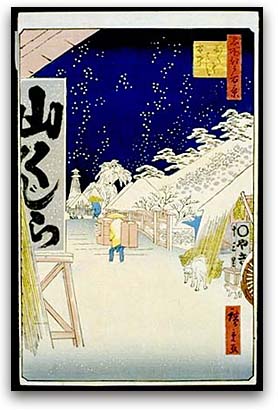| |
The Edo Era (1603—1867), during which a full-fledged feudal system was established by the Tokugawa shogunate, was also an era in which the culture of townspeople flourished. That Japan had already developed distinctive advertising techniques of its own as early as the Edo Era might come as a surprise to you. But ample evidence of these remain for us today to follow a historical trail, in the form of nishiki-e (a multicolored woodblock print), hikifuda (handbills) and signboards. A witness of the times, as well as a chronicle of advertising creative work in Japan, these relics represent a valuable record of both the evolution of corporations and the history of common people's lives.

In this nishiki-e, two signs are seen in the snow: a butcher's shop sign that says, "Yama-kujira (mountain whale)," and a baked sweet potato vendor's "Maruyaki Jusan-ri" sign. Both signs are word plays, which reflect Edoites' love of fun. Yama-kujira is the meat of wild boars. The shop, whose name was Owari-ya, served wild boar's meat cooked with leek in an earthenware pot. The sign "Maruyaki (baked whole)" written on a paper-covered lamp stand of the baked sweet potato vendor was derived from the manner the potatoes were baked whole. The characters "Jusan-ri (13 ri, approx. 32 miles)" beside it is a pun: Because 13 ri is a sum of 9 ri (pronounced as kuri , it has the same sound as that of chestnuts) and 4 ri (pronounced yori, it is a homonym of the word that means "better than"), it meant "tastier than chestnuts." Shown in the center of the nishiki-e is a peddler making his round, carrying baskets of merchandise on a pole.
| |

